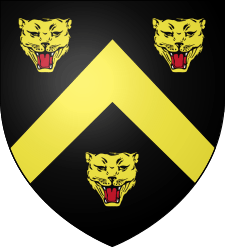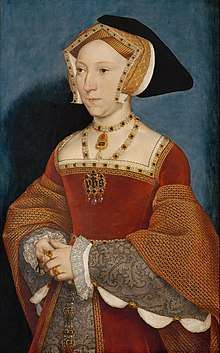Philip Wentworth
| Sir Philip Wentworth | |
|---|---|
 Wentworth coat of arms: Sable, a chevron between three leopard's faces, or | |
| Born |
c. 1424 England |
| Died |
18 May 1464 Middleham, Yorkshire |
| Spouse(s) | Lady Mary de Clifford |
| Children |
Henry Wentworth Margaret Wentworth Elizabeth Wentworth |
| Parent(s) |
Roger Wentworth Margery le Despencer |
Sir Philip Wentworth, Knight, of Nettlestead, Suffolk (c. 1424 – 18 May 1464) was an English knight and courtier. Wentworth was the great grandfather of Jane Seymour[1], third wife of King Henry VIII, and was beheaded at Middleham, Yorkshire.
Biography
Philip Wentworth was the son of Roger Wentworth (died 24 October 1462), Esquire, of North Elmsall, Yorkshire, and wife Margery le Despencer (died 1478) daughter and heiress of Philip le Despencer, 2nd Baron le Despencer, and wife Elizabeth de Tibetot.[2][3][lower-alpha 1]
Wentworth was Usher of the King's Chamber, King's Sergeant, Esquire of the Body, King's Carver, Sheriff of Norfolk and Suffolk (1459–1460), Knight of the Shire for Suffolk, Constable of Llanstephen and Clare Castles, Chief Steward of the Honour of Clare.[2]
Wentworth supported the house of Lancaster and was in the army of King Henry VI, which was defeated at the Battle of Hexham on 15 May 1464. He was captured and three days later beheaded at Middleham, Yorkshire on 18 May 1464.[2]
Family

Wentworth married Mary, daughter of John Clifford, 7th Baron de Clifford and wife Lady Elizabeth Percy, daughter of Henry Percy (Hotspur) and his wife Lady Elizabeth Mortimer.[4] When Mary died, she was buried at the Friars Minor at Ipswich, Suffolk.[2]
They had a son and two daughters who survived him:[4]
- Sir Henry Wentworth,[2] de jure 4th Baron Despenser, of Nettlestead, Suffolk, who married firstly Anne Say, by whom he had two sons, Sir Richard and Edward, and four daughters, Elizabeth, Margery, Dorothy and Jane, and secondly Elizabeth Neville, by whom he had no issue. His daughter, Margery Wentworth, married Sir John Seymour of Wolf Hall and had several notable children, including Jane Seymour, third wife of King Henry VIII and Queen of England.[5]
- Margaret Wentworth, who married Thomas Cotton, esquire.[2]
- Elizabeth Wentworth,[2] who married, as his second wife, Sir Martin De La See, Knight, of Barmston, East Riding of Yorkshire, son of Brian De La See, by Maud, daughter of John Monceaux.[6].
In November 2017, Gary Boyd Roberts reported that through their daughter Elizabeth and her husband Sir Martin De La See, Sir Philip and Dame Mary Wentworth are the direct ancestors of former American actress Meghan, Duchess of Sussex, wife of Prince Harry, Duke of Sussex.[7][8]
Ancestry
| Ancestors of Philip Wentworth | |||||||||||||||||||||||||||||||||||||||||||||||||||||||||||||||||||||||||||||||||||||||||||||||||||||||||||||||||||||||||||||||||||||||||||||||||||||||||||||||||||||||||||||||||||||||||||||||||||||||||||||||||||||||||||||||||||||||||||||||||||||||||||||||||||||||||||||||||||||||||||||||||||||||||||||||||||||||||||||||||||||||||||||||||||||||||||||||||||||||||||||||||||||||||||||||||||||||||||||||||||||||||||||||||||||||||||||||||||||||||||||||||||||||||||||||||||||||||||||||||||||||||||||||||||||||||||||||||||||||||||||||||||||||||||||
|---|---|---|---|---|---|---|---|---|---|---|---|---|---|---|---|---|---|---|---|---|---|---|---|---|---|---|---|---|---|---|---|---|---|---|---|---|---|---|---|---|---|---|---|---|---|---|---|---|---|---|---|---|---|---|---|---|---|---|---|---|---|---|---|---|---|---|---|---|---|---|---|---|---|---|---|---|---|---|---|---|---|---|---|---|---|---|---|---|---|---|---|---|---|---|---|---|---|---|---|---|---|---|---|---|---|---|---|---|---|---|---|---|---|---|---|---|---|---|---|---|---|---|---|---|---|---|---|---|---|---|---|---|---|---|---|---|---|---|---|---|---|---|---|---|---|---|---|---|---|---|---|---|---|---|---|---|---|---|---|---|---|---|---|---|---|---|---|---|---|---|---|---|---|---|---|---|---|---|---|---|---|---|---|---|---|---|---|---|---|---|---|---|---|---|---|---|---|---|---|---|---|---|---|---|---|---|---|---|---|---|---|---|---|---|---|---|---|---|---|---|---|---|---|---|---|---|---|---|---|---|---|---|---|---|---|---|---|---|---|---|---|---|---|---|---|---|---|---|---|---|---|---|---|---|---|---|---|---|---|---|---|---|---|---|---|---|---|---|---|---|---|---|---|---|---|---|---|---|---|---|---|---|---|---|---|---|---|---|---|---|---|---|---|---|---|---|---|---|---|---|---|---|---|---|---|---|---|---|---|---|---|---|---|---|---|---|---|---|---|---|---|---|---|---|---|---|---|---|---|---|---|---|---|---|---|---|---|---|---|---|---|---|---|---|---|---|---|---|---|---|---|---|---|---|---|---|---|---|---|---|---|---|---|---|---|---|---|---|---|---|---|---|---|---|---|---|---|---|---|---|---|---|---|---|---|---|---|---|---|---|---|---|---|---|---|---|---|---|---|---|---|---|---|---|---|---|---|---|---|---|---|---|---|---|---|---|---|---|---|---|---|---|---|---|---|---|---|---|---|---|---|---|---|---|---|---|---|---|---|---|---|---|---|---|---|---|---|---|---|---|---|---|---|---|---|---|---|---|---|---|---|---|---|---|---|---|---|---|---|---|---|---|---|---|---|---|---|---|---|---|---|---|---|---|---|---|---|---|---|---|---|---|---|---|---|---|---|---|---|---|---|---|---|---|---|---|---|---|---|---|---|---|---|---|---|---|---|---|---|---|---|---|---|---|---|---|---|---|---|---|---|---|---|---|---|---|---|---|---|---|---|
| |||||||||||||||||||||||||||||||||||||||||||||||||||||||||||||||||||||||||||||||||||||||||||||||||||||||||||||||||||||||||||||||||||||||||||||||||||||||||||||||||||||||||||||||||||||||||||||||||||||||||||||||||||||||||||||||||||||||||||||||||||||||||||||||||||||||||||||||||||||||||||||||||||||||||||||||||||||||||||||||||||||||||||||||||||||||||||||||||||||||||||||||||||||||||||||||||||||||||||||||||||||||||||||||||||||||||||||||||||||||||||||||||||||||||||||||||||||||||||||||||||||||||||||||||||||||||||||||||||||||||||||||||||||||||||||
Notes
- ↑ Browning, C. (1911). Americans of Royal Descent. Genealogical Publishing Com. pp. Pedigree CXII: page 525. Retrieved 9 December 2017.
- 1 2 3 4 5 6 7 8 Richardson 2011, p. 214.
- ↑ Lundy 2011, p. 346 § 3451 cites Mosley 2003, p. 1107; Mosley 2003a, p. 2441.
- 1 2 Richardson 2011, pp. 214, 541–542.
- ↑ Metcalfe 1882, p. 77.
- ↑ Harvey & et al 1930, pp. 78–79.
- ↑ Roberts, Gary Boyd (30 November 2017). "The Shared Ancestry of (Rachel) Meghan Markle and Prince Harry" (PDF). American Ancestors. Retrieved 7 December 2017.
- ↑ Child, C. (30 November 2017). "The Wentworth connection". vita-brevis.org. Retrieved 18 December 2017.
References
- Harvey, W.; et al. (1930). "Visitations of the North 3". Surtees Soc. 144: 78–79.
- Lundy, Darryl (19 June 2011). "Margaret Despenser". p. 346 § 3451.
- Mosley, Charles, ed. (2003). Burke's Peerage, Baronetage & Knightage. 1 (107th, in 3 volumes ed.). Wilmington, Delaware, U.S.A.: Burke's Peerage (Genealogical Books). p. 1107.
- Mosley, editor-Charles, ed. (2003a). Burke's Peerage, Baronetage & Knightage. 2 (107th, in 3 volumes ed.). Wilmington, Delaware, U.S.A.: Burke's Peerage (Genealogical Books). p. 2441.
- Metcalfe, Walter C., ed. (1882). The Visitations of Suffolk. Exeter: William Pollard. p. 77.
- Richardson, Douglas (2011). Plantagenet Ancestry (2nd ed.). Douglas Richardson. pp. 214, 541–542. ISBN 9781461045137.
Further reading
- Blore, Thomas (1811). The History and Antiquities of the County of Rutland. Stanford: R. Newcomb.
- Metcalfe, Walter C., ed. (1878). The Visitations of Essex. XIII. London: Harleian Society. p. 314.